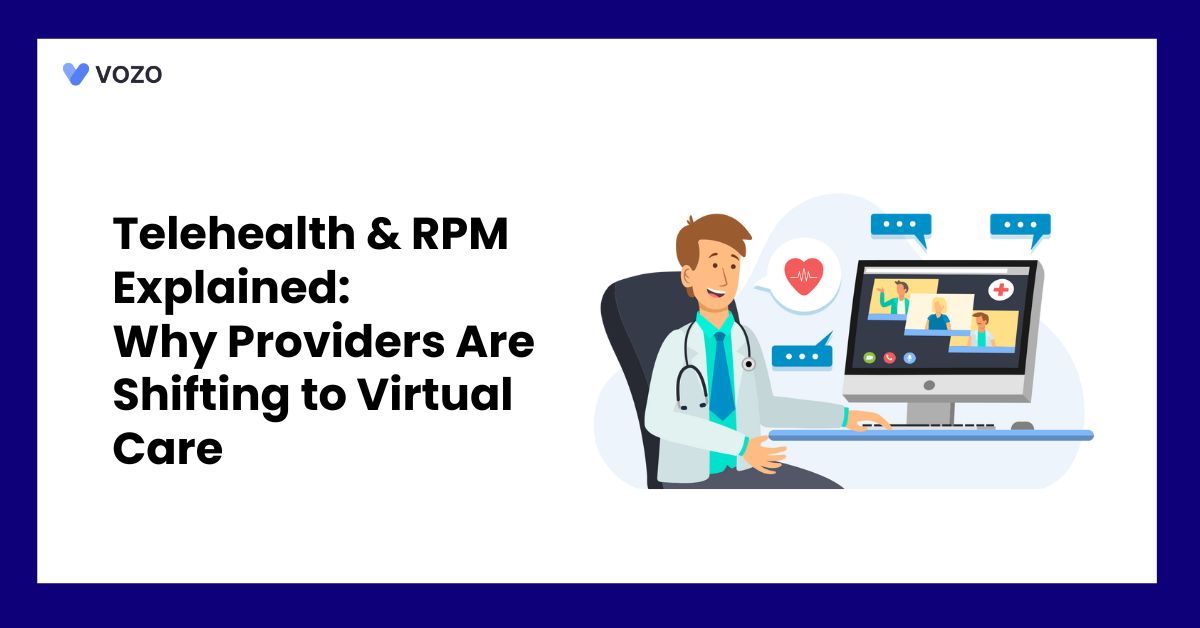Telehealth & RPM Explained: Why Providers Are Shifting to Virtual Care
Remote patient monitoring and telehealth have revolutionized the way healthcare is delivered. More patients are currently receiving virtual care as a result of growing acceptance, and as clinicians use remote health technology, RPM usage is predicted to increase quickly, particularly in the United States.
Here you will know what telehealth & RPM are, their key characteristics, how patients and providers benefit, why providers need to shift to virtual care, and the future trends in them.
What is Telehealth & RPM
Telehealth involves using digital platforms to deliver healthcare services through virtual consultations. It includes RPM, which enables providers to track patients’ health remotely and improve care delivery across various locations.
Remote Patient Monitoring is used to monitor patients’ health remotely using RPM devices. It allows patients to interact with providers about their health progress. RPM allows providers to monitor patients’ vital signs, health conditions.
How Telehealth Works?
- Scheduling appointments – Appointments for virtual consultations are scheduled via websites or mobile applications.
- Interacting with Provider for Health Consultation – Patients can use secure video conferencing to discuss their symptoms and receive medical advice from their respective providers.
- Diagnosis & Treatment – Doctors prescribe medications, recommend food habits, or do lab tests remotely.
- Follow-up & Monitoring – Patients can track their progress through digital health records and remote monitoring devices.
Related: 5 Ways Vozo Telehealth Makes Virtual Health Consultation Better
Features of Telehealth & RPM
Telehealth
- Telehealth allows people to communicate with their healthcare providers by video, phone, or secure messaging.
- Simple scheduling and reminders are sent via SMS and email to ensure that people attend their appointments and track their health care.
- Patients receive educational materials like tutorials and PDFs to comprehend their treatment plans and medications.
- Telehealth platforms connect with EHR systems to facilitate easy access to patient records and enhance communication among providers.
Remote Patient Monitoring
- Vital signs are monitored using RPM devices, such as heart rate and blood pressure. These devices alert if there is a change in vital signs. Patients suffering from chronic diseases such as diabetes and hypertension can utilize the RPM device to manage their health.
- The RPM system permits providers to oversee and facilitate the early identification of health problems, averting potential issues.
- By applying data analysis methods, healthcare organizations can examine patient information gathered from RPM devices to monitor patients’ health.
- RPM delivers patient-focused care and enhances patient involvement by enabling communication with healthcare providers.
Related: How to Set Up a Remote Patient Monitoring System for Your Clinic
Benefits of RPM and Telehealth for Patients and Providers
Patients
- Through telehealth, patients in underserved or rural places can consult with experts. It is possible to arrange virtual calls at the patient’s convenience.
- In addition to saving time and money, patients can avoid traveling for in-hospital visits. It allows for continuous monitoring and support.
- RPM enhances patient wellness through ongoing tracking and provides tailored treatment plans with real-time data.
- Early detection of issues can avoid or delay treatments and reduce hospitalization. It helps to increase patient activation by talking to their providers.
Providers
- Telehealth reduces the costs of physical infrastructure and increases revenue through patient count.
- Telehealth streamlines workflows, reduces wait time, which allows providers to see more patients. Few no-shows due to automated reminders.
- By monitoring vital signs, providers can identify issues and improve patient care. RPM allows for focus on patients who need immediate care.
- RPM generates data that helps to improve patient care, identify trends, and develop more effective treatment strategies.
Related: Top Benefits of Telehealth for Urgent Care: A Guide for Providers and Patients (2025)
Why Providers Need to Shift to Virtual Care
Expanding Access
Telemedicine provides medical services to remote and underserved populations, considerably cutting travel costs and improving healthcare equity. Every year, virtual visits save patients and health-care systems millions of money by eliminating the need for travel and time away from work.
Virtual mental health services bridge gaps, particularly where provider shortages are severe, to increase utilization among vulnerable groups.
Boosting Operational Efficiency
Telehealth consultations had a 29% lower no-show rate than in-person appointments, resulting in more productive scheduling and increased provider usage. Automated reminders reduce administrative work. Over six months, remote monitoring and virtual visits save patients more than $360 each.
Improving Patient Engagement
Most patients are satisfied with their telehealth experiences, with many mentioning convenience and lower wait times. Flexible scheduling and digital check-ins boost medication and appointment adherence, leading to improved health outcomes and stronger provider-patient relationships.
Future Market Growth
The global telehealth market is forecast to nearly double from $94.1 billion in 2024 to $180.9 billion by 2030 (CAGR 11.5%), with US telemedicine alone expected to increase from $32.3 billion in 2024 to $172.6 billion by 2034. Providers who adopt virtual care now will gain a competitive advantage by leveraging data-driven insights, scaling care delivery, and satisfying patient expectations for convenient, tech-enabled services.
Related: How Integration of Remote Patient Monitoring and Telehealth Benefits
Vozo Cloud EHR With Built-In Telehealth Platform
If you are searching for the best EHR system for your healthcare practice, Vozo EHR can be your go-to choice. Our comprehensive EHR solution lets you focus more on patient care while carrying all the burdens and simplifying them.
- Vozo Cloud EHR’s cost-effective cloud subscription benefits all levels of practice.
- Our feature-rich EHR helps you rectify mistakes efficiently and speed up the process.
- Vozo Specialty EHR resonates with specialty practice needs and requirements.
- Our expert technical team gets you covered 24/7 if any needs arise.
Our EHR System continues to scale as your healthcare practice grows to improve the user experience.
The Vozo Customized EHR solution benefits your healthcare practice by:
- Streamlining the administrative process
- Improving workflow efficiency
- Reducing proneness to errors
- Manages all the patients’ records in one place
- Offers greater efficiency and cost savings across the board.
Our specialty-specific tools, like scheduling, patient portals, lab integration, cloud hosting, and more, meet the specific needs and requirements of your healthcare practice.
“Embrace Vozo EHR to Reduce Your Burdens and Enhance Patient Care”
About the author

With more than 4 years of experience in the dynamic healthcare technology landscape, Sid specializes in crafting compelling content on topics including EHR/EMR, patient portals, healthcare automation, remote patient monitoring, and health information exchange. His expertise lies in translating cutting-edge innovations and intricate topics into engaging narratives that resonate with diverse audiences.













